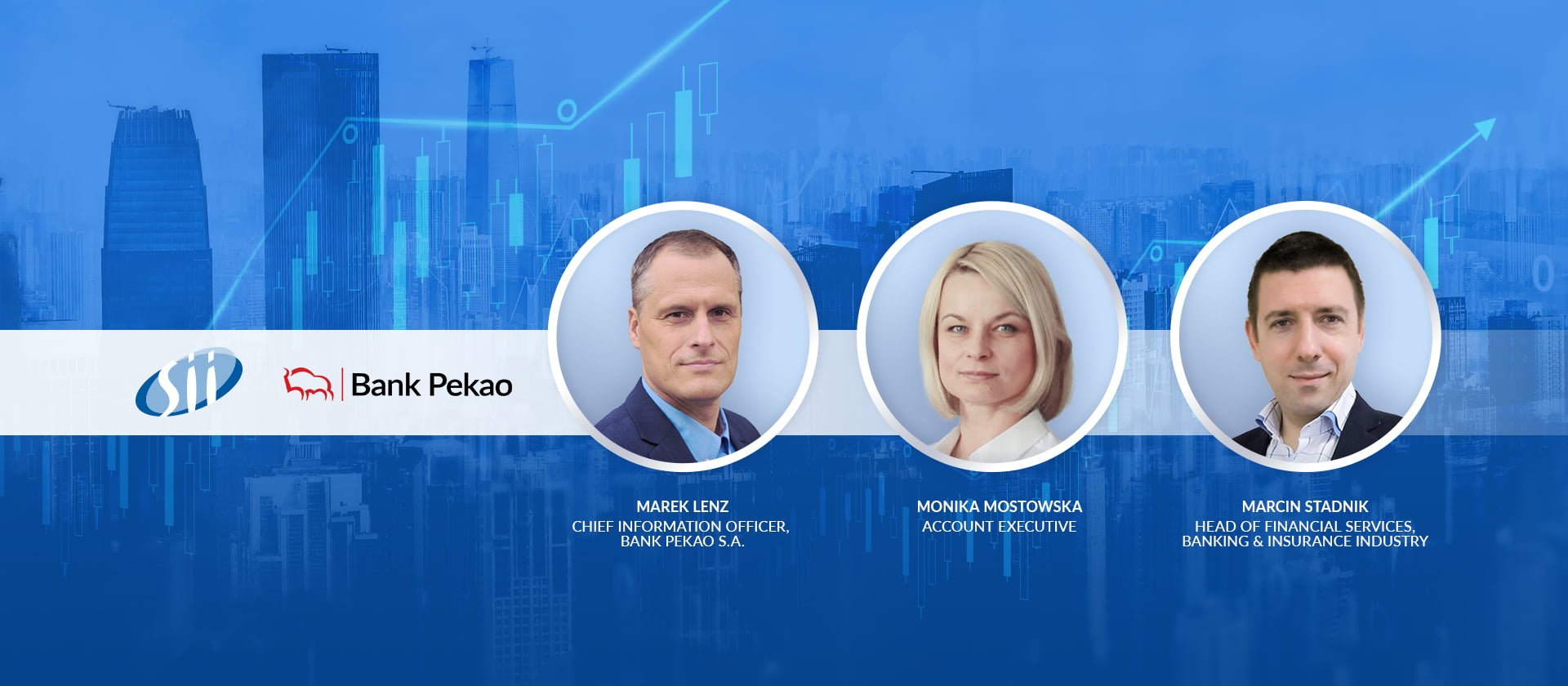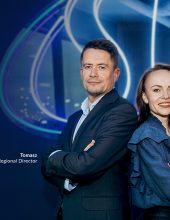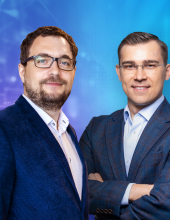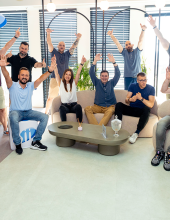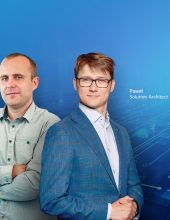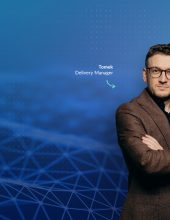Digitization of banking processes in times of pandemic. Interview with Marek Lenz, CIO at Bank Pekao S. A.
In connection with the COVID-19 pandemic, the situation of the banking sector in Poland has changed dramatically, posing unprecedented challenges. The unforeseeable crisis meant that banking institutions needed to implement effective solutions that ensured continuity and efficiency almost overnight. In an interview with Marcin Stadnik, Head of Industry Banking, Insurance & Financial Services at Sii Poland, and Monika Mostowska, Account Executive at Sii Polska, Marek Lenz, CIO at Bank Pekao S. A., has spoken about the difficulties encountered, the tools he relied on during the pandemic, as well as the prospects for the future.
Marcin Stadnik, Head of Industry at Sii Poland: A year and a half after you had become CIO at Pekao, the second largest bank in Poland, the economy faced a crisis that put all sectors to the test. How did this situation affect the way IT services are delivered in your organization?
Marek Lenz, CIO at Bank Pekao S. A.: Taking on the position of CIO at Bank Pekao S. A. in October 2018, I got on a very fast-moving train. The bank had been in the midst of large, dynamic changes for a year, which almost entirely focused on the accelerated digitization of banking processes. The key changes in IT systems concerned, on the one hand, improving the quality of user interfaces in electronic channels and, on the other hand, increasing the efficiency and speed of processes to lower operating costs.
The pandemic came as a huge surprise to the bank, as to many other institutions. First of all, we had to allow more than 14 thousand employees to work remotely in two weeks. This required, first of all, expanding VPN access and rapidly increasing the number of available laptops by almost 5 000. Not only did we have to allow office employees to work, but also to move Call Center and Trading to remote work, which until then we thought had been impossible.
In the second phase, we made very rapid changes to our business processes and user interfaces to maximize the use of remote self-service by our customers. It has to be noted that as Pekao we are a large bank in terms of the number of both retail and corporate customers. Therefore, the changes had to be implemented separately in our retail banking ecosystem, in applications such as PeoPay and Pekao24, as well as in the ecosystem for servicing corporations in PB24 and other applications.
Another major challenge was to implement specific packages of the anti-crisis shield solutions, which were supposed to protect the Polish state and citizens from the crisis caused by the coronavirus pandemic, in a very short time. Here again, in cooperation with the PFR and other government agencies, in just a few weeks we implemented changes in our systems, allowing customers to use the anti-crisis shield.
In short, the pandemic has significantly accelerated the IT changes that the bank was planning or already implementing.
Monika Mostowska, Account Executive at Sii Poland: At Sii we noticed that the pandemic changed the face of cooperation between IT and business – the biggest revolution is remote work and the dispersal of teams. We also observed a partial suspension of investment decisions among our clients in 2020 and their substantial increase in 2021. Have you also noticed changes in these areas?
M. L.: The pandemic forced huge changes in the way the IT and business world cooperate. The first and biggest change was the remote work itself, which, apart from the IT area, was rather rare in Bank Pekao. In the face of the new situation, all meetings became online meetings overnight. It would certainly take us a decade to introduce such a change organically, and this happened in just a few weeks. This, in turn, created the need to work based on tools for remote work, including the basic ones like Outlook and Skype, as well as those more often used by IT specialists like Jira, Wiki, etc. This style of work and tools were a big novelty for many business entities, but due to the situation, they were quickly adopted by them.
Today we are working to further improve the ways and tools of cooperation. A few months ago we implemented MS Teams, used by more than 11 000 users. We are currently working on making all M365 tools available to employees. Their launch, divided into several stages, is planned for the turn of this and next year.
After more than 1.5 years, remote work has become the new norm for us. In many areas, it has helped us to significantly increase our productivity. Now we look into the future and wonder what hybrid work, i.e. a combination of remote work and office work, will look like. On the one hand, we are trying to prepare tools that will support us in this process, such as flexible office infrastructure, terminals, business mobile applications for booking workspace, parking lots, etc. On the other hand, we are wondering how to organize work to maximize the effectiveness of direct, on-site teamwork and combine it with the benefits of remote work.
M. M.: You currently manage a team of 1 200 people. What is your biggest challenge?
M. L.: I think that the biggest challenges faced when managing such a large team are still connected with remote work. They are mainly related to building an organizational culture and team integration, which previously took place through working in an open space, drinking coffee in the kitchen, face-to-face meetings, integration trips, training, etc. Direct contact has always been one of the most important factors motivating me to work, but unfortunately, the pandemic has taken it away from us. That is why, I look forward to hybrid work and think about how to plan it most effectively, not only from the point of view of the cooperation tools but also human interaction.
The second biggest challenge is currently the recruitment of qualified IT experts. On the one hand, the pandemic has opened up some opportunities for us to recruit remote employees from outside of large urban agglomerations where we have offices (Warsaw, Łódź, Szczecin, Lublin), but on the other hand, it has created pressure from global companies that are recruiting more and more IT specialists from Poland to work remotely abroad.
M. S.: Did the crisis caused by the pandemic affect the technological development direction taken by the bank? In what new technologies will the bank invest in the near future?
M.L.: The pandemic as such did not change the technological development direction, but rather accelerated and strengthened it. The technology on which we are currently most focused is the widely understood “cloud computing”.
On the one hand, we have invested a lot in the development of our internal cloud platform and now most of our systems for electronic channels are based on it. To achieve this, we had to modernize the architecture of our key applications, moving from a monolithic approach to a micro-service approach, in containers on the Kubernetes platform. This required a lot of work, including building a number of new competences in the team.
On the other hand, we are working intensively on the use of the public cloud and system migration in areas where cloud technologies will bring us the greatest benefits i.e. in the area of digital channels, Call Center, CRM. This requires addressing the technological and regulatory challenges that are a barrier to the widespread use of such services. At the moment, Pekao uses public cloud services mainly to support non-critical activities that do not require the processing of legally protected data, and for non-critical processes in the organization.
Another technological area in which we invest is “intelligent” automation. In this case, we use advanced methods and models (deep learning) to analyze the text and, for example, determine the client’s attitude or automatically classify cases. We develop own tools for image recognition and document analysis that do not work based on templates, but advanced analytics (the possibility to work with unstructured documents) with added models (deep learning) for document classification.
We are also working on democratization, i.e. spreading automation. We run the Robotization Academy, as part of which we develop the digital competence of bank employees, equip them with skills and tools for creating automation by themselves – building robots for personal use.
M. M.: For Sii, the partnership with the Bank has always been of strategic importance – you were one of our first clients, with whom we started cooperation when our company was composed of several people. Now there are over 6 000 of us in Poland, and this success is possible thanks to our clients, including Pekao. What do you value Sii for?
M. L.: Sii has been a partner of Pekao for a very long time. I personally have several years of experience in cooperating with Sii, both in Bank Pekao S.A. and in previous companies.
From my perspective, the answer to this question is very simple – I value Sii for always looking after the interests of the client. When contacting Sii employees, I know that they will always try to find a solution that meets my needs as much as possible. As little and as much.
M. S.: Digitization of enterprises seems inevitable. Who do you think will win this race?
M. L.: Yes, I agree, further digitization is inevitable. Who will win? First of all, companies that are ready to invest in technology and people who can use and build it, and at the same time act in a bold way. For example, companies from the so-called GAFAM Group (Google, Amazon, Facebook, Apple, Microsoft) are known for embracing business models in other markets. Banks must act similarly, be technologically strong and attentive, because today without technology, continuous observation and development there is no banking. If they do not, the prediction of Brett King, the author of Bank 4.0 – banking yes, but in a world without banks, may come true.
If you would like to learn more about Sii Poland’s support for the financial services, banking and insurance sectors, visit our website.

